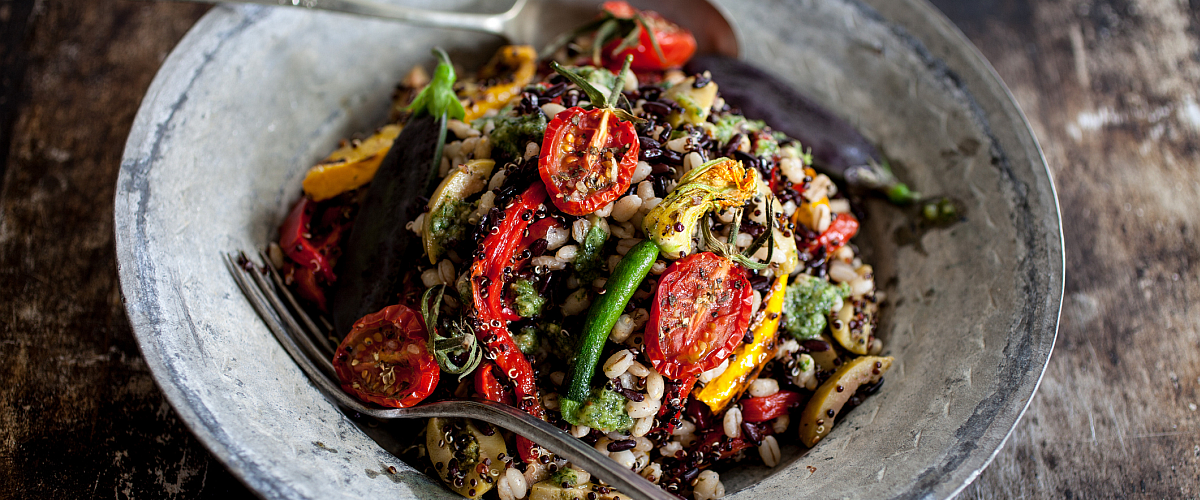It’s hard to deny that whole grains are having a moment in our meals and in our hearts. Take a look at menus across America and you’ll notice whole grains—like brown rice and oats—as well as more exotic grains—like farro and wheat berries—are popping up everywhere.
And for good reason. Whole grains contain the bran and germ that would otherwise be stripped away during processing. That means they are high in nutrients including fiber, which, according to the American Heart Association (AHA), can improve blood cholesterol and lower your risk of heart disease, stroke, obesity, and even type 2 diabetes.
The AHA recommends that at least half our daily grains should be whole. So, how exactly do we go about adding more whole grains to our daily meals?
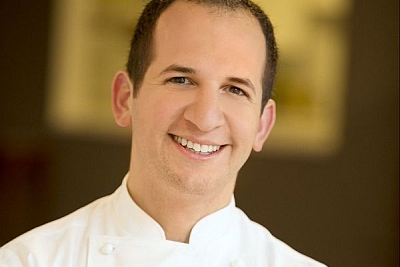
For inspiration, we spoke with a whole-grain master: Andrew Moltz, Executive Research Chef at Quaker, an Aramark partner. Here he teams up with our chefs to provide cooking tips and recipes to help you make the grain.
Flavor, Texture, Fuel
Whether you’re a professional chef or a home cook, there is a lot to love about whole grains. They may take a little more time to prepare—for example, cooking brown rice takes about twice as long as white rice. But the added taste, texture, and nutrition make them well worth it.
“Whole grains offer a wide range of flavors, as well as a palette of colors and textures that can really liven up a meal,” Chef Andrew shares. “Refined grains often get lost in a dish. But when cooked properly and paired well, whole grains almost always deliver a more fulfilling food experience.”
Simmer Down
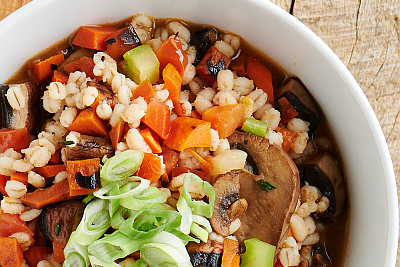
As with many aspects of cooking, it comes down to technique. Boiling whole grains will cause them to expand too much, Chef Andrew explains. That’s why it’s best to simmer the cooking liquid instead. Your grains are fully cooked when they are plump and tender, rather than soft and mushy.
“Your goal is to maintain the shape that the grains had prior to cooking,” he adds.
Follow package cooking directions and times carefully (we like this handy cooking guide from The Whole Grains Council). It’s okay to slightly undercook whole grains if you know they will be heated up again later—say, in a soup.
Another trick of the trade is to break out the pressure cooker. It’s a fail-safe way to make whole grains at home that also reduces the cooking time, Chef Andrew tells us.
Think Outside the (Cereal) Box
Another great thing about whole grains is that they’re very versatile. Their mild flavors form a foundation for endless meals and snacks.
Take quinoa, which you’ve surely had in a salad or as the base for a dinner bowl. But have you ever tried it in the morning? Check out this Spiced Breakfast Quinoa for a morning treat that’s hearty, a little sweet, and oh, so satisfying.
Of course, everyone loves oats for breakfast—we even named them your morning MVP. But what if you took oats in a savory direction for lunch or dinner?
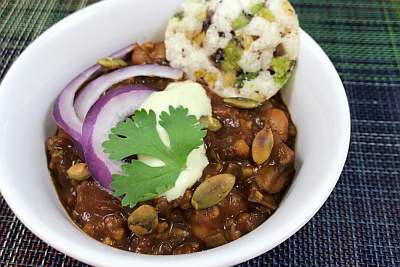
“Oats are frequently under-used,” says Chef Andrew. “They are traditionally served in sweet preparations, but they absorb other flavors well, too.”
Take Quaker’s Spicy Chili with Steel Cut Oats, for example, sure to warm you up through the fall and winter. This zesty recipe calls for steel cut oats—or a combination of steel cut oats and ground beef or turkey—for a tasty, plant-forward take on your favorite game-day meal. The resulting texture is similar to meat, but the oats provide more fiber, less fat, and lower (or no) cholesterol. What’s more, the steel cut oats join forces with the beans to provide complete protein.
Start out by subbing only half the meat with oats, Chef Andrew suggests. You can increase the ratio each time you make the recipe.
Meals the Whole Family Will Love
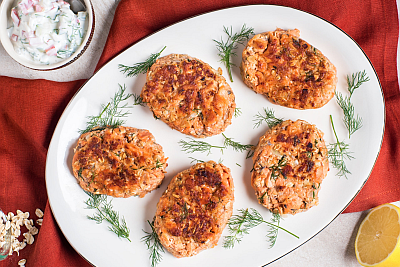
Unsure if your family will go for oats in chili? Quaker’s easy ABC Meatball Soup is made from only six ingredients and we bet you have them all on hand. The meatballs are made with uncooked quick or old-fashioned rolled oats, ground meat, and either prepared BBQ sauce or ketchup. Add broth, alphabet pasta, and frozen mixed vegetables—and voila! A comforting meal that’s ready in minutes.
Meanwhile, Quaker’s Dilled Salmon Cakes make an upscale choice for brunch, lunch, or dinner. They’re topped with a sauce made from nonfat yogurt, cucumbers, tomatoes, and delicious dill.
Here’s another satisfying entrée that’s a departure from the usual: our Beets and Bulgur Salad. It combines a hearty whole grain with layers of herbed orange chicken, chickpeas, feta and a delicious sherry vinaigrette.
Wholly on Board
We hope this helps you think about healthy whole grains in a whole new light. Make them the centerpiece of your meals, or substitute them for meat, and you’ll soon be in the habit of choosing whole grains over refined.
Next time you’re preparing a meal that includes a grain, consider reaching for oats (ideally steel cut or whole oat groats). “There really is no limit to where oats can be taken,” Chef Andrew says.
Want to learn more about these nutrition powerhouses? Our dietitian maps out everything you need to know in The Whole Story on Whole Grains.
Note: Since everyone’s health history and nutritional needs are so different, please make sure that you talk with your doctor and a registered dietitian to get advice about the diet and exercise plan that‘s right for you.

